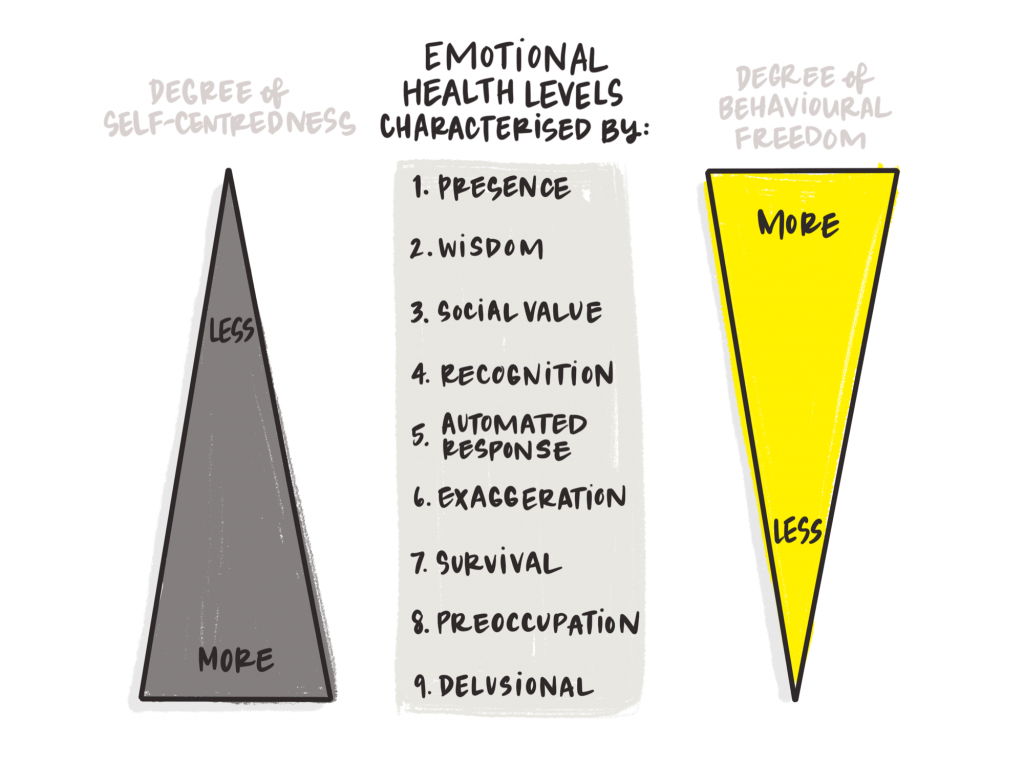Over the many years we’ve been writing our blog posts, there is one framework we refer to almost every month. It is emotional health, which is, of course, central to our intent of raising emotional health levels across the globe. In separate posts we have discussed most of the principles that support emotional health, including the line of choice, the centres of intelligence and the inner observer, along with the application of emotional health to many situations.
Often in these posts we talk in general terms, comparing the differences between having a ‘high’ level of emotional health and having a lower level of emotional health. However, one thing we have not discussed in any detail are the emotional health levels themselves – hence this month’s topic.
In our model of emotional health, there are nine levels ranging from the highest, level 1 – ‘Presence’, to the lowest, level 9 – ‘Delusional’. In this post we will discuss the concept of the different levels in practice and explore the most common levels in a little more detail.
To briefly recap: higher levels of emotional health correspond to a lower degrees of self-centredness and higher degrees of behavioural freedom. In addition, a person with a higher level of emotional health will exhibit above-the-line responses to situations more often than someone with a lower level of emotional health.

A person at level 1 – the highest level of emotional health – is extremely rare. Such a person is ‘in presence’ with their environment, themselves and others and is fully conscious of the impact they are having at any moment. They are completely open, well balanced and liberated from any degree of self-centredness.
In contrast, a person at level 9, the lowest level of emotional health, is entirely focused on their own needs and completely out of touch with reality. They have no behavioural freedom to choose their responses to situations and react in ways that may well cause harm to themselves and/or others.
Most of us sit somewhere closer to levels 4, 5 or 6. Let’s look at these three levels in a little more detail.
Level 4 – Recognition
A person at this level recognises they have choices in how they respond and behave. On a regular basis, they begin to observe themselves and the impact they have on others and the environment. These observations support them in increasing their level of consciousness, which in turn leads to a greater degree of behavioural freedom.
At level 4, a person starts to better integrate the body, head and heart centres through conscious choices and mindful practices, thus creating moments of ‘presence’ which enable them to appreciate and distinguish the benefits this brings. They can still display some ineffective below-the-line patterns of behaviour, though such responses are less likely to have a negative impact on others.
Level 5 – Automated response
At this level (generally that of around 50% of the Western population), a person is dominated by a range of automated responses to situations they find themselves in. These automated responses are mostly defensive and reactive and are about staying in control (which may include controlling others), seeking attention and validation and/or finding ways to stay safe in order to get their perceived needs met.
There is also very limited self-observation and a reliance on only two of the three centres of intelligence. They have less freedom to catch the ‘magic quarter second’, so reacting with greater personal responsibility is very difficult. Nevertheless, typically when the pressure is off, a person at this level is capable of making decisions and displaying automated responses that are less self-centred.
Level 6 – Exaggeration
At this level a person is more ‘demonstrative’ in their defences than a person at level 5. Their reactions are exaggerated as they over-compensate due to internal fears and anxieties. Their thinking takes place largely from the perspective of their preferred centre of intelligence, with limited connection to the other two. Their inner observer is very ineffective and they lack the capacity to reflect on their behaviours and therefore change them. As with level 5, though less often, the person at level 6 is capable, when circumstances allow, of making some choices in their reactions.
—–
It is important to know that we are never ‘locked into’ to a particular level. We all have good days and not-so-good days, and it’s quite reasonable that on the former we might operate at a higher emotional health level than on the latter. We can also improve our emotional health level over time – which is exactly what we aim to help people do in our work.
It’s also important to understand that none of what we are describing here is absolute. In practice, different people at the same emotional health level will have different responses and reactions, depending on their individual makeup or personality.
To learn more about the concept of emotional health levels, including descriptions of all nine levels, see our book Working with Emotional Health and the Enneagram.
Gayle and Malcolm

